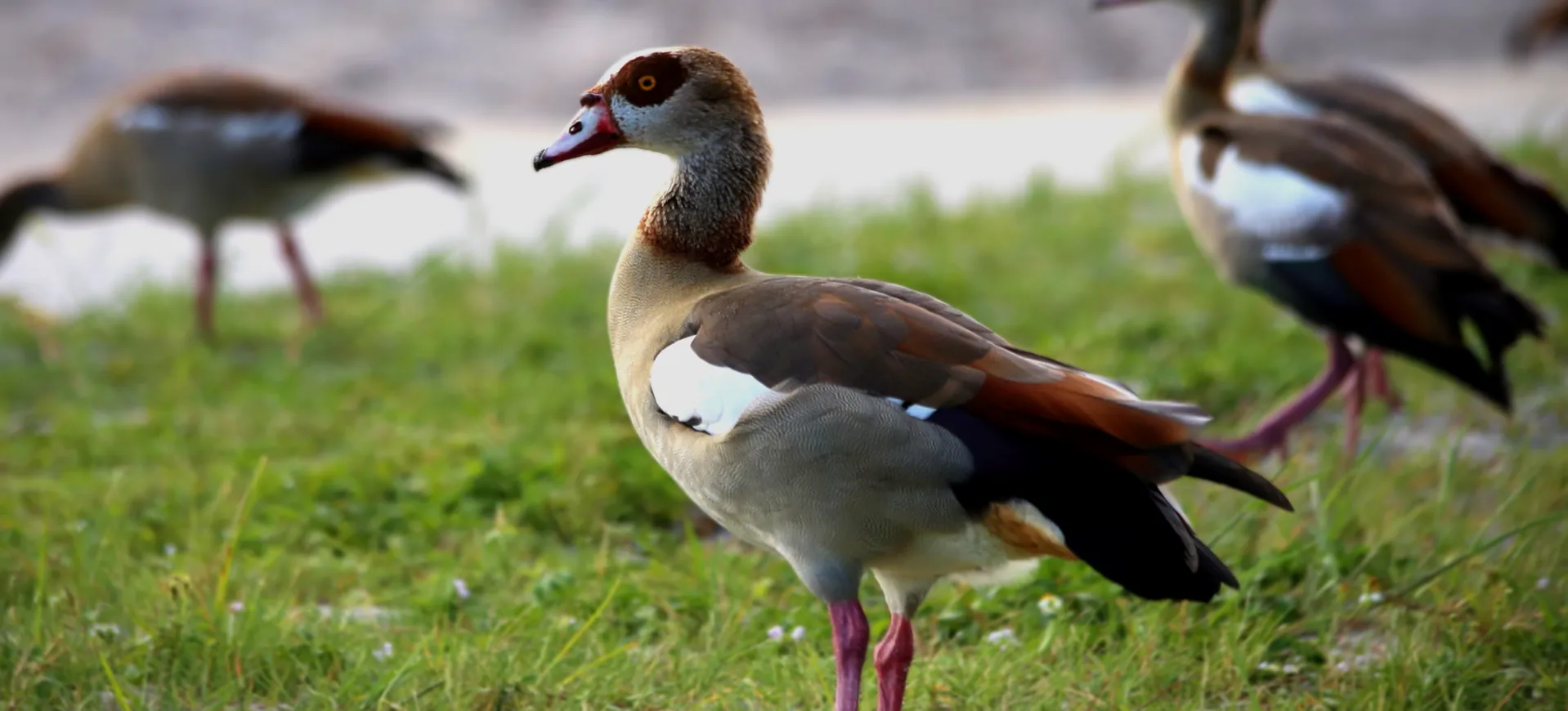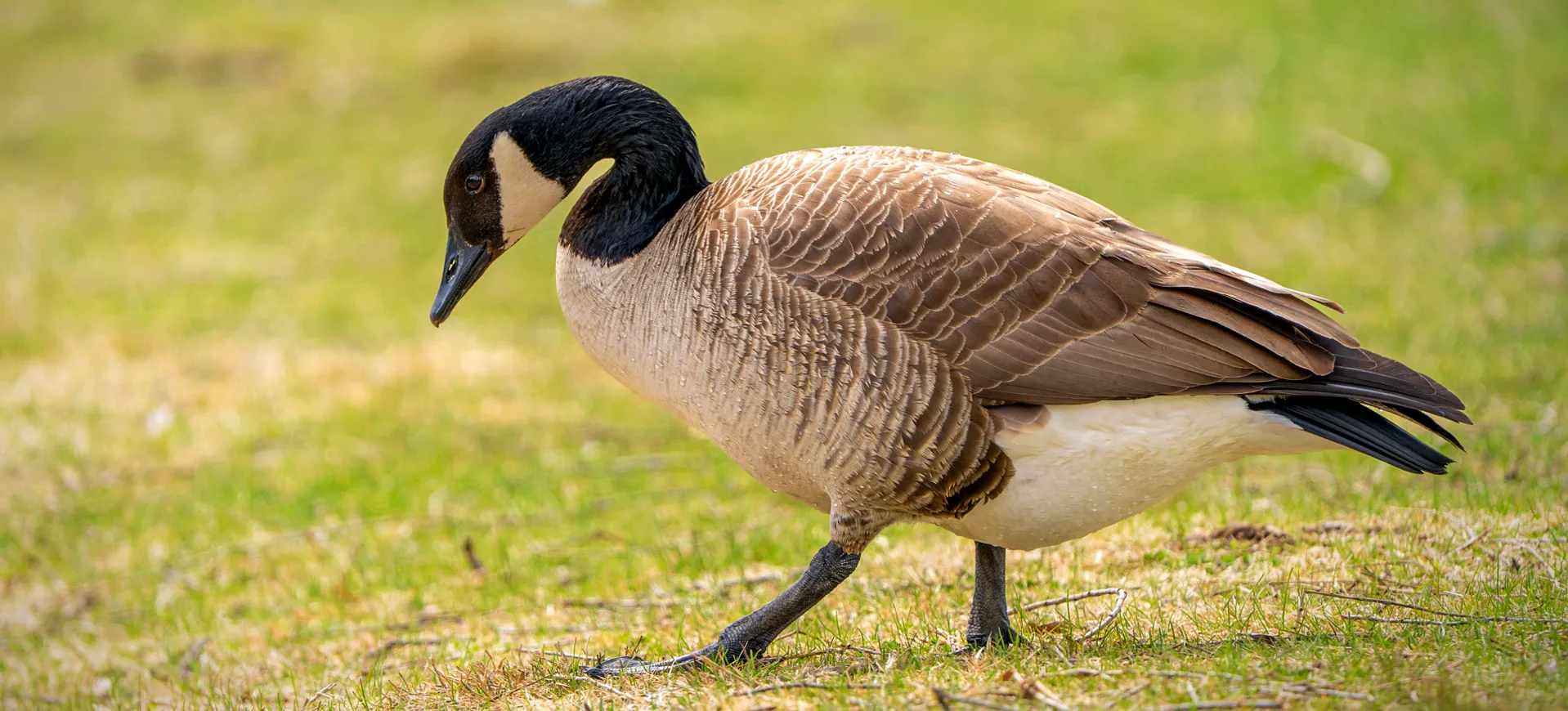Overview
The Nene, also known as the Hawaiian Goose, is a bird endemic to the Hawaiian Islands. It is the official state bird of Hawaii and is distinguished from other geese by its unique adaptations to the Hawaiian habitat. The Nene evolved from the Canada Goose, which most likely arrived in Hawaii about 500,000 years ago and has since adapted to the island’s volcanic landscapes. Unlike most other geese, the Nene is a non-migratory bird, largely due to the favorable climate of its island habitat.
The Nene has a black face, crown, and cream-colored cheeks, creating a striking contrast. Its neck is long and slender, covered in furrows and streaks of black and white. The bird’s body is predominantly barred in shades of brown, with a buff-colored underbelly. Its adaptability to the volcanic environment is evident in its reduced webbing on the feet, which facilitates walking on rugged terrain.
The Nene’s call is quite distinct from other geese, being more muted and gentle. It is also known for its strong pair bonds, often remaining with a single mate for life. During the breeding season, these birds become more territorial and engage in various displays of affection and territorial defense.
Taxonomy
Kingdom
Phylum
Class
Order
Family
Genus
Species
Type
Physical Description:
The Nene is a medium-sized goose, smaller and stockier than most geese. The adult Nene measures about 16 inches in height and approximately 24 to 28 inches in length. Its wingspan is noteworthy, ranging from 40 to 46 inches, enabling the bird to glide effortlessly over short distances. The coloration of its feathers provides excellent camouflage against the Hawaiian volcanic landscapes.
Sexual dimorphism in Nenes is subtle, with males generally being slightly larger and having a more pronounced head and neck. The plumage of both sexes is similar, aiding in camouflage and protection from predators. The reduced webbing in their feet, along with stronger, clawed toes, is a unique feature that helps them navigate the rocky and uneven surfaces of the Hawaiian Islands. The Nene’s expressive eye and serene demeanor make it a particularly endearing bird to observers.

Lifespan: Wild: ~8 Years || Captivity: ~20 Years

Weight: Male: 4.4-5.3 lbs (2-2.4 kg) || Female: 3.5-4.4 lbs (1.6-2 kg)

Length: Male: 24-28 inches (61-71 cm) || Female: 22-26 inches (56-66 cm)

Height: Male: 16-18 inches (40-45 cm) || Female: 14-16 inches (35-40 cm)

Wingspan: Male & Female: 40-46 inches (101-117 cm)

Top Speed: 25 mph (40 km/h)
Characteristic:
Native Habitat:
The Nene is native to the Hawaiian Islands and has adapted to various habitats. Historically, these birds could be found from coastal dunes to high volcanic slopes. They are particularly adapted to shrubland, grassland, and sparsely vegetated volcanic terrain, demonstrating remarkable adaptability. The Nene’s natural habitat includes open lowland and montane regions up to 8,000 feet.
Due to loss and other threats, the Nene’s habitat range has become more restricted. However, in recent times, ongoing conservation efforts have been focused on habitat restoration and protection. The bird’s current habitats include national parks, private lands, and specially protected areas. Efforts to increase the Nene’s range are crucial for its continued survival and proliferation.
Climate Zones:
Biomes:
Biogeographical Realms:
Continents:
Countries:
Diet:
Diet & Feeding Habits:
The Nene’s diet mainly consists of vegetation, showcasing its adaptability to the Hawaiian ecosystem. They feed on grasses, leaves, fruits, and flowers, often foraging on the ground. The bird’s diet changes seasonally, depending on the availability of different plant species. The Nene plays a crucial role in seed dispersal, aiding in the propagation of native Hawaiian flora.
Unlike many other waterfowl, the Nene is not heavily dependent on aquatic environments for feeding. It has adapted to consume a broader range of terrestrial plant matter; a trait evolved in response to the limited freshwater sources on the Hawaiian Islands. The bird’s beak is well-adapted for grazing, allowing it to clip grasses and leaves easily. Interestingly, Nenes have also been observed eating small insects, supplementing their primarily herbivorous diet.
Mating Behavior:
Mating Description:
The Nene is known for its strong monogamous pair bonds, often forming lifelong partnerships. During the breeding season, pairs become more territorial and can be seen engaging in various courtship behaviors. These behaviors include mutual preening, head bobbing, and soft calling, strengthening their bond. The breeding season typically occurs from August to April, varying slightly depending on the island.
Nesting is a critical part of the Nene’s reproductive cycle. Females build nests on the ground, using vegetation to create a well-concealed space. They lay between 1 to 5 eggs per clutch, with the incubation period lasting about 30 days. Both parents are involved in rearing the goslings, teaching them to forage and protect themselves from predators. The goslings are precocial and can walk and feed themselves shortly after hatching.
Reproduction Season:
Birth Type:
Pregnancy Duration:
Female Name:
Male Name:
Baby Name:
Social Structure Description:
The Nene is known for its friendly nature, particularly outside the breeding season. They are often found in small flocks, although larger congregations can occur in areas with abundant food resources. The social hierarchy within these groups is not very pronounced, and there is generally a peaceful coexistence. During the breeding season, however, pairs become territorial and may distance themselves from others to protect their nesting area.
Various vocalizations and body language characterize Nene’s social interactions. They communicate through honks, grunts, and hisses, especially in social gatherings or when threatened. Parental care is a significant aspect of their social behavior, with both parents actively raising their offspring. The strong pair bonds and family ties observed in Nenes are a notable aspect of their social structure.
Groups:
Conservation Status:
Population Trend:
The Nene population experienced a dramatic decline during the 20th century, primarily due to habitat loss, introduced predators, and human disturbance. By the 1950s, the wild population had dwindled to as few as 30 individuals. This alarming decline prompted significant conservation efforts, including captive breeding programs, habitat management, and predator control. These efforts have been successful, with the wild population increasing steadily over the past few decades.
Despite the increase, the Nene remains vulnerable due to its limited range and ongoing threats. Predation by introduced mammals, such as mongoose, cats, and dogs, is a significant concern. Additionally, habitat destruction and fragmentation continue to pose challenges. The bird’s dependence on specific habitats makes it susceptible to land use and climate change. Conservation programs focus on habitat protection, predator control, and population monitoring to ensure the Nene’s survival.
Population Threats:
The primary threats to the Nene population include predation, habitat loss, and human disturbance. Introduced predators, such as feral cats, dogs, and mongoose, pose a significant risk, especially to eggs and goslings. Habitat loss due to agricultural development, urbanization, and invasive plant species has also impacted the Nene’s natural environments. Additionally, collisions with vehicles on roads near their habitats are a notable cause of mortality.
Climate change poses an emerging threat, potentially impacting the Nene’s habitat and food sources. Weather patterns can affect the availability of water and vegetation, which is crucial for their survival. Disease outbreaks, such as avian malaria and avian pox, are additional concerns, particularly in areas where mosquitoes are prevalent. Ongoing research and monitoring are essential to understanding and mitigating these threats effectively.
Conservation Efforts:
Conservation efforts for the Nene have been ongoing since the mid-20th century, with significant successes. Captive breeding and reintroduction programs have been pivotal in increasing the wild population. These programs involve breeding Nenes in captivity and then releasing them into suitable habitats, often within national parks and protected areas. Habitat management, including the restoration of native vegetation and the creation of predator-free zones, has been crucial. Education and awareness programs help in involving local communities in conservation activities.
Monitoring of Nene populations is an ongoing activity, helping conservationists to track their numbers and health. Habitat restoration projects have been successful in some areas, encouraging the return of these birds to their natural environments. The success of these efforts is evident in the gradual increase in the Nene population and the expansion of their range within the Hawaiian Islands. Future conservation plans include habitat expansion, continued protection from predators, and research into genetic diversity to ensure a healthy, sustainable population.
Additional Resources:
Fun Facts
- The Nene is the world’s rarest goose.
- It is the sixth most endangered waterfowl species globally.
- Unlike most geese, the Nene does not migrate.
- Its feet are less webbed than other geese, an adaptation to the volcanic terrain.
- The Nene has a very soft and muted call compared to other geese.
- It was designated the state bird of Hawaii in 1957.
- The Nene can live at altitudes up to 8,000 feet.
- It is believed that the Nene evolved from the Canada Goose.
- The Nene’s primary threat is from introduced predators like mongooses and feral cats.
- Conservation efforts have helped increase its population from 30 birds in the 1950s to around 2,500-3,000 today.
















































































